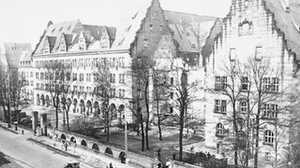The International Military Tribunal

In the Moscow Declaration of October 1943, United States President Franklin D. Roosevelt, British Prime Minister Winston Churchill, and Soviet Premier Joseph Stalin formally stated their determination to bring Nazi war criminals to justice. Roosevelt later warned, "none who participated in these acts of savagery shall go unpunished. All who share in the guilt shall share in the punishment."
Debating Punishments
But what would an appropriate punishment be? After a long and brutally destructive war, many felt no outcome was too severe for the Nazis who had brought the world into chaos. Churchill believed that Nazi leaders should be "hunted down and shot." United States Secretary of the Treasury Henry Morgenthau agreed, and formulated a plan that would punish Germany by deindustrializing its economy and summarily executing Nazi leaders. But when New York newspapers leaked the Morgenthau Plan, some critics were outraged by its vindictive terms. An alternative plan, formulated by Secretary of War Henry Stimson and attorney Lieutenant Colonel Murray Bernays, proposed that Nazi organizations be tried for criminal conspiracy, making any member guilty by default of the racism, terrorism, and atrocities committed. Before the Americans settled on their position, in April 1945, Roosevelt died. With the American Army dividing Germany and Nazi collapse imminent, President Harry Truman decided to proceed with a trial, appointing Supreme Court Justice Robert Jackson as chief counsel. He soon secured British cooperation and the stage was set for an international trial.
Prosecuting "Aggressive War"
In August 1945 the Americans, British, Soviets, and French signed the London Charter of the International Military Tribunal (I.M.T.), which created the Nuremberg court and set the ground rules for the trial. No precedent existed for who should be put on trial, on what charges, and where the proceedings should be held. The Geneva and Hague Conventions, intended to protect the sick and wounded in wartime, had defined war crimes, but the Allied powers wanted to go further, seeking to prosecute the waging of aggressive war, the violation of sovereignty, and the perpetration of crimes against humanity. These crimes had not been defined under international law, exposing the Allies to accusations of ex post facto prosecution -- that is, punishing actions that had not been established as crimes when they were committed. In addition the tribunal was criticized for considering only acts of Axis aggression, not those undertaken by the Allies. Despite its shortcomings, the tribunal remained a milestone. For the first time, an international authority would hold political and military leaders accountable for atrocities committed in the name of a state.
Palace of Justice
The Allies indicted 24 Nazi leaders on four counts: conspiracy to wage aggressive war, crimes against peace, war crimes, and crimes against humanity, defined as "murder, extermination, enslavement, deportation ... or persecutions on political, racial, or religious grounds." The I.M.T. also indicted Nazi organizations, including the Reich Cabinet, the Leadership Corps of the Nazi Party, the Elite Guard (SS), and the Secret State Police (Gestapo). The Allies appointed prosecutors and judges, and then arranged and paid for the defendants' attorneys, who were largely German. The Soviet Union wanted the trial held in Soviet-occupied Berlin, but the trial was held in the American sector of Germany. In the city of Nuremberg, a former location of Nazi Party rallies, was a Palace of Justice that had largely escaped damage by Allied bombers. It contained 20 courtrooms and a prison capable of holding 1,200 prisoners. The Allies doubled the main courtroom in size, built visitors' and press galleries, and installed a simultaneous translation system to communicate the proceedings in English, French, German, and Russian.
Twelve Sentenced to Hang
The International Military Tribunal convened on October 18, 1945, in Berlin -- at the insistence of the Soviet Union -- where prosecutors delivered the indictments. Then the court adjourned to Nuremberg for the trial, which began November 20, 1945, and lasted until October 1946. Over 400 visitors attended the daily proceedings, with 325 correspondents representing 23 different countries. The trial gave the world its first close look at the horror of the Holocaust. Of the 24 indicted Nazi leaders, 22 were tried: one, Robert Ley, had committed suicide while in custody; another, Gustav Krupp stood down due to illness. Martin Bormann was thought to be dead, but since his body had not been recovered, he was tried in absentia. Three of the 22 defendants were acquitted; nineteen were found guilty. Three were sentenced to life in prison, four to prison terms from ten to 20 years, and 12 to death, including Hermann Göring, who committed suicide the night before his scheduled execution. Four Nazi organizations were declared criminal, and although the General Staff and High Command of the Nazi government was not declared criminal, they were condemned by the Tribunal as "a ruthless military caste."
Legacy
The trial at Nuremberg represented an enormous achievement in international law. It was the first time a nation's leaders were prosecuted by the international community for crimes committed by the state. The rules created during the trial formed the basis for future international conventions and principles for war.







